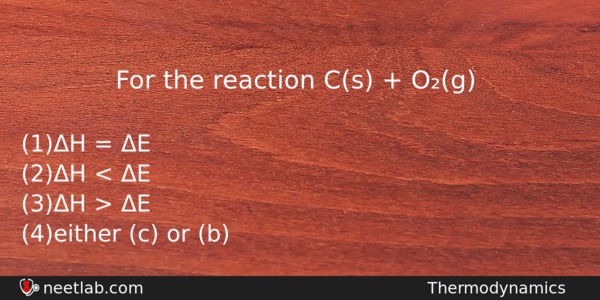| ⇦ | 
| ⇨ |
For the reaction C(s) + O₂(g)
Options
(a) ΔH = ΔE
(b) ΔH < ΔE
(c) ΔH > ΔE
(d) either ΔH > ΔE or ΔH < ΔE
Correct Answer:
ΔH = ΔE
Explanation:
In the reaction C(s) + O₂(g) → CO₂(g), there is no change in the number of moles of gaseous components (Δn = 1 – 1 = 0).
As ΔH = ΔE + ΔnRT. Thus in this case ΔH = ΔE.
Related Questions: - The term-dc/dt in a rate equation refers to
- Which of the following oxides is not expected to react with sodium hydroxide
- Position of hydrogen in periodic table is such that it can be placed in
- Which one of the following on reaction with excess of MeMgI would give a tertiar
- Which one among the following is most reactive towards electrophilic substitution
Topics: Thermodynamics
(179)
Subject: Chemistry
(2512)
Important MCQs Based on Medical Entrance Examinations To Improve Your NEET Score
- The term-dc/dt in a rate equation refers to
- Which of the following oxides is not expected to react with sodium hydroxide
- Position of hydrogen in periodic table is such that it can be placed in
- Which one of the following on reaction with excess of MeMgI would give a tertiar
- Which one among the following is most reactive towards electrophilic substitution
Topics: Thermodynamics (179)
Subject: Chemistry (2512)
Important MCQs Based on Medical Entrance Examinations To Improve Your NEET Score
18000+ students are using NEETLab to improve their score. What about you?
Solve Previous Year MCQs, Mock Tests, Topicwise Practice Tests, Identify Weak Topics, Formula Flash cards and much more is available in NEETLab Android App to improve your NEET score.
Share this page with your friends

Leave a Reply